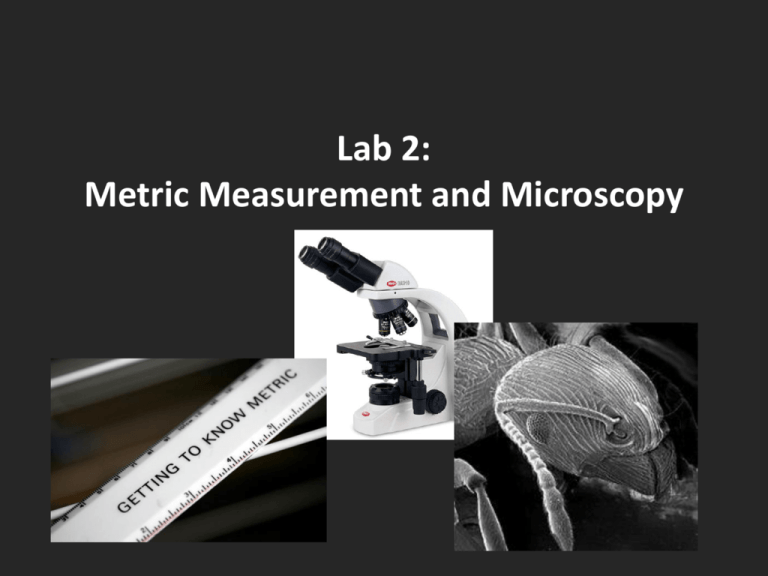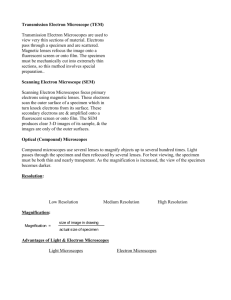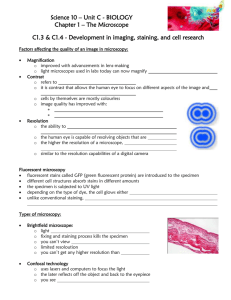Lab 2: Metric Measurement and Microscopy
advertisement

Lab 2: Metric Measurement and Microscopy The Metric System • “SI” Metric is the standard system of measurement used in the sciences. • Why use metric? – Official system of almost every country. – Less confusing if scientists use the same measurement system. – Based on units of ten, which makes converting units easy! How To Read A Metric Ruler ? Metric Basics • Most measurements have two parts, a BASE UNIT and PREFIX. • The prefix tells you how to modify the base unit – either larger or smaller. • Start with the base unit and then examine the prefix to determine what to do next. Know Your Prefixes! PREFIX Kilo- PREFIX MEANING ? Centi- ? Milli- ? Micro- ? Nano- ? EXPONENT 103 10-2 10-3 10-6 10-9 Know Your Prefixes! PREFIX KiloCentiMilliMicroNano- PREFIX MEANING Thousand (1,000.0) Hundredth 0.01 or 1/100 Thousandth 0.001 or 1/1,000 Millionth 1/1,000,000 Billionth (1/1,000,000,000) EXPONENT 103 10-2 10-3 10-6 10-9 Quick Conversions 5.0 m ___ mm • Find out what your target unit’s exponent is: 1.0 mm = 10-3 m • Which unit is larger? What direction do you need to move the decimal point? Since the unit you are converting to (mm) is smaller, then move decimal to the right by 3. Conversion Factors 1. Take what you have… Know what you need. 5 m → ___ mm 2. Figure out your conversion factor. Since 1,000 mm = 1 m Your conversion factor would be: 1,000 mm The unit you want to 1m get rid of ALWAYS goes on the bottom Conversion Factors 3. Multiply by your conversion factor. 5 m x 1,000 mm = ? 1m 5m x 1,000 mm 1m = 5,000 mm More Difficult Conversion Factors 1. Sometimes you may want to use more than one conversion factor... 68 mm → ___ μm (micrometers) 1 m = 1,000 mm 1 m = 1,000,000 μm 2. Create your conversion factors: 1m 1,000,000 μm 1,000 mm 1m More Difficult Conversion Factors 3. Multiply 68 mm x 1m x 1,000,000 μm = ? μm 1000 mm 1m 68 mm x 1m x 1,000,000 μm = ? μm 1000 mm 1m 68 x 1 x 1,000 μm = 68,000 μm How To Calculate Solid Volume Volume of a rectangular prism: V = Length x Width x Depth V = ____ cm3 (cubic cm) How To Calculate Liquid Volume: Use the Meniscus! • Sometimes liquid molecules are more attracted to surface of container than each other. • The MENISCUS is the bottom of the curve – that is the true volume! Common Units: • Liters (L) • Milliliters (mL) How To Read Volume: Use the Meniscus! • Make sure to read graduated cylinder at EYE LEVEL. • If you read at an angle you will either under- or overestimate. Types of Microscopes Optical Microscopes • Examine specimen using your light and optical lenses • Lower magnification • Can view live organisms • May require dyes to see detail • Lower resolution • • • • • Electron Microscopes Examine specimen with electrons Higher magnification Can view only dead organisms Requires specimen to be coated with heavy metals Higher resolution Resolution • Resolution = the minimum distance between two adjacent objects required so they can be distinguished. • Compound light microscope – 200 nm • Transmission electron microscope – 0.1 nm Optical Microscopes Stereomicroscope • Allows you to view the surface of an opaque 3D specimen Compound Light Microscope • Allows you to view flat, translucent specimens The Compound Optical Microscope • Light enters the microscope from the bottom. • Travels through multiple lenses (hence the name compound). • The lenses magnify & bend the light to your eye. • Note: The image may be inverted if there is no projector lens. • Parfocal = if focused in low power, it will be focused in higher power “Anatomy” of the Compound Optical Microscope Compound Optical Microscope: Objective Lenses • Most of these microscopes have four lenses: – Scanning objective – Low power objective – High power objective – Oil immersion objective • Eyepiece is also a lens (ocular lens) • Total magnification = ocular x objective Electron Microscopes Transmission Electron Microscope • Allows you to view flat, translucent specimens Scanning Electron Microscope • Allows you to view the surface of a 3D specimen Methylene Blue / Iodine Solution • • • • Common staining solutions Careful! May stain clothing, hands, equip. It is an irritant - don’t taste or inhale Avoid contact with eyes and skin. Today’s Specimens • Human epithelial cells – Epithelial tissue lines all the inner and outer surfaces of the body • Onion epidermal cells • Euglena – Unicellular protist – Capable of consuming other organisms (phagocytosis) for food or creating food by photosynthesis What Can You Identify in Euglena? •Nucleus contains the cell’s DNA •Eye spot detects light •Contractile vacuoles are multipurpose storage containers •Mitochondria are the “power plants” •Flagella rotate in a corkscrew to move the cell Handling Microscopes Hold microscopes with two hands. One holding the arm and the other underneath the base.







